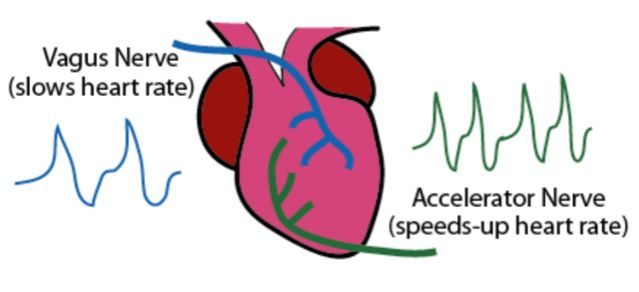This post is a follow-up to, "Diaphragmatic Breathing Exercises and Your Vagus Nerve," from my nine-part series on combating fight-or-flight physiology. For this post, I'm excited to update what was primarily hypothetical speculation a few years ago with some new scientific literature (Gerritsen & Band, 2018 and De Couck et al., 2019). These studies corroborate that longer exhalations are an easy way to hack the vagus nerve, combat fight-or-flight stress responses, and improve HRV.
You might be asking, "What is HRV?" Heart rate variability represents the healthy fluctuation in beat-to-beat intervals of a human or animal's heart rate. During the inhalation phase of a breathing cycle, the sympathetic nervous system (SNS) facilitates a brief acceleration of heart rate; during exhalation, the vagus nerve secretes a transmitter substance (ACh) which causes deceleration within beat-to-beat intervals via the parasympathetic nervous system (PNS).
HRV is used to index the robustness of someone's vagus nerve responses and vagal tone (VT). Higher HRV is associated with stronger vagus nerve function, lower chronic stress levels, better overall health, and improved cognition.
Although much of the clinical research on HRV doesn't always discuss the vagus nerve, it's well established that HRV is an effective way to index vagal tone and gauge the robustness of someone's physiological ability to counteract SNS-driven fight-or-flight stress responses.
Nota bene: I grew up in a household with a neuroscientist father, Richard Bergland (1932-2007), who was also a brain surgeon and author of The Fabric of Mind. My dad idolized Nobel-prize winner Otto Loewi (1873-1961), who discovered the first neurotransmitter (acetylcholine), which is the chief neurotransmitter of the PNS. What we now refer to as acetylcholine or ACh was originally coined "vagusstoff" (German for "vagus substance") by Loewi around 1921.
In a simple but elegant experiment on frogs (that came to Loewi as a Eureka! moment in a dream), he found that a tranquilizing substance squirted directly out of the vagus nerve onto the heart, which caused a frog's heart rate to slow down immediately. (See, "How Does "Vagusstoff" (Vagus Nerve Substance) Calm Us Down?")

Dad kept his neuroscience lessons on the tennis court simple. He'd say, "Chris, if you want to maintain grace under pressure, visualize squirting some vagusstoff into your nervous system by taking a deep breath-with a big inhale and a long, slow exhale-as you bounce the ball four times before every serve."
Without going into too much detail, my father taught me that by increasing the duration of my exhale after taking a deep breath, I could trigger my vagus nerve to squirt out some stress-busting "vagusstoff" on demand. This "stuff" was like a self-made tranquilizer that would relax my nerves and help me avoid choking or double-faulting during match points.
Later in life, when I was a student at Hampshire College, I practiced yoga regularly and was guided by an instructor who also emphasized the importance of focusing on the inhalation/exhalation ratio during yogic breathing exercises. Although he didn't mention anything to do with neurobiology or psychophysiology, it was clear that many of the breathing techniques my yoga instructor was teaching emphasized longer exhalations, just like my father had taught me on the tennis court.
Based solely on life experience and insights from my dad, I saw a parallel and had a hunch that these centuries-old methods of shifting the inhalation/exhalation ratio that often had long-winded Sanskrit names such as "bhastrika pranayama" were ancient vagal maneuvers unwittingly designed to hack the vagus nerve long before Otto Loewi discovered vagusstoff.
It's reassuring to have fresh research corroborate that each of us can trigger a "relaxation response" (Benson et al., 1975) simply by focusing on the inhalation-to-exhalation ratio of our breathing and consciously extending the length of each exhale while doing breathing exercises as we go about our day-to-day lives.
New Research Identifies Multiple Benefits of Longer Exhalations
In 2018, Roderik Gerritsen and Guido Band of Leiden University in the Netherlands published a detailed theoretical review, "Breath of Life: The Respiratory Vagal Stimulation Model of Contemplative Activity," in the journal Frontiers in Human Neuroscience. This review presents a wide range of studies that illustrate how slower respiration rates and longer exhalations phasically and tonically stimulate the vagus nerve. Using diaphragmatic breathing techniques to kickstart the calming "rest and digest" influence of the parasympathetic nervous system is referred to as respiratory vagus nerve stimulation (rVNS). For more on traditional VNS and non-invasive vagus nerve stimulation (nVNS) see here, here, here, and here.
Throughout their paper, Gerritsen and Band explain how the latest research on rVNS fits into a historical timeline of other techniques used for millennia to harness runaway fight-or-flight stress responses and calm the autonomic nervous system. The authors write:
"The breathing techniques used in contemplative activities (e.g., meditation, yoga, tai chi) include, but are not restricted to, slowing down respiration cycles, shifting to longer exhalations compared to inhalations, shifting the main locus of respiration from the thorax to the abdomen (diaphragmatic breathing), or paying attention to "natural" breathing. Especially slow and deep breathing with emphasis on long exhalation is dominant across traditions, including zen and vipassana-though there are a few practices stimulating faster respiration patterns (i.e., the yoga technique "breath of fire"). The [vagus] nerve, as a proponent of the parasympathetic nervous system (PNS), is the prime candidate in explaining the effects of contemplative practices on health, mental health and cognition.Another recent study (De Couck et al., 2019) published this month, "How Breathing Can Help You Make Better Decisions: Two Studies on the Effects of Breathing Patterns on Heart Rate Variability and Decision-Making in Business Cases," reports that just two minutes of deep breathing with longer exhalation engages the vagus nerve, increases HRV, and improves decision-making. These findings were published in the May issue of the International Journal of Psychophysiology.
Frequently adopting these respiration patterns (slowed and with longer exhalations) can explain a significant part of the efficacy found within contemplative activity practice. Though contemplative activities are diverse, they have shown a similar pattern of beneficial effects on health, mental health, and cognition: mostly in stress-related conditions and performance. This pattern can be explained by these controlled breathing exercises.
Clearly, these functions all move the system towards the rest-and-digest mode of operation and away from fight-or-flight. Not only does [the] vagus nerve control heart rate and slow deep breathing; slow respiration rates with extended exhalation could also activate the PNS by vagus nerve afferent function in the airways. This is a form of respiratory biofeedback. Slow breathing techniques with long exhalation will signal a state of relaxation by the vagus nerve, resulting in more VN activity and further relaxation. Though VN involvement can explain the effects on health and mental health, the link with cognition is less clear. One of the links between respiration and cognition is HRV."
This two-pronged study was conducted by researchers from Vrije Universiteit Brussel in Belgium. The first arm of this study found that both slow deep "symmetric" breathing patterns (with an equal ratio of inhaling/exhalation timing) and skewed "vagus nerve" breathing patterns (with a longer exhalation than inhalation) significantly increased HRV.
The second arm of this study asked one group of participants to perform two minutes of skewed vagus nerve breathing before taking a 30-minute decision-making test. The control group watched a video and did not focus on breathing patterns. Notably, participants in the group who focused on breathing patterns with longer exhalations for two minutes reported lower levels of stress and provided a significantly higher percentage of correct answers to business-related test questions than controls. The authors conclude, "These studies show that brief vagal breathing patterns reliably increase HRV and improve decision-making."
There are a myriad of different breathing patterns you can use to improve HRV. That said, based on the latest research, practicing rVNS breathing via longer exhalations for just two minutes appears to be an easy way to hack the vagus nerve and calm one's nervous system.
One gadget-free way to track the timing of your inhalation-to-exhalation breathing cycles per minute is to use a 4:8 ratio of four-second inhalations and eight-second exhalations. This breathing cycle takes 12 seconds which equates to five inhalation/exhalation cycles per minute. Based on road-tested outcomes, I really like the 4:8 ratio because it's easy to use my right hand to count up to five with each digit and use the fingers on my left hand like an abacus to keep track of each one-minute cycle.
Anytime you want to hack your vagus nerve to reduce stress or improve decision-making, a simple self-talk script could be: "I'm stressing out. In order to calm down so I can perform better on this decision-making task, I'm going to take two minutes (right now!) to do ten rounds of vagus nerve breathing based on a 4:8 inhalation-to-exhalation ratio."
During the four-second inhalation phase, I'd recommend breathing in through your nose-as you relax the back of your eyes and visualize filling up your lower diaphragm with oxygen-and slowly count to four. Then, I'd recommend exhaling through pursed lips (as if you're blowing out lots of candles on a birthday cake) as you slowly count to eight.
Remember: If you're feeling especially stressed out, you can increase your rVNS breathing time to five minutes or a total of 25 twelve-second 4:8 breathing cycles. Repeat as needed.
About the AuthorReferences
Christopher Bergland is a world-class endurance athlete, coach, author, and political activist. His website is www.theathletesway.com.
Roderik J. S. Gerritsen and Guido P. H. Band. "Breath of Life: The Respiratory Vagal Stimulation Model of Contemplative Activity" Frontiers in Human Neuroscience (First published online: October 9, 2018) DOI: 10.3389/fnhum.2018.00397
Marijke De Couck, Ralf Caers, Liza Musch, Johanna Fliegauf, Antonio Giangreco, and Yori Gidron. "How Breathing Can Help You Make Better Decisions: Two Studies on the Effects of Breathing Patterns on Heart Rate Variability and Decision-Making in Business Cases." International Journal of Psychophysiology (First published online: March 1, 2019) DOI: 10.1016/j.ijpsycho.2019.02.011
Kyle J. Bourassa, John J.B. Allen, Matthias R. Mehl, and David A. Sbarra. "The Impact of Narrative Expressive Writing on Heart Rate, Heart Rate Variability, and Blood Pressure Following Marital Separation." Psychosomatic Medicine (First published: May 8, 2017) DOI: 10.1097/PSY.0000000000000475
Bethany E. Kok, Kimberly A. Coffey, Michael A. Cohn, Lahnna I. Catalino, Tanya Vacharkulksemsuk, Sara B. Algoe, Mary Brantley, and Barbara L. Fredrickson. "How Positive Emotions Build Physical Health: Perceived Positive Social Connections Account for the Upward Spiral Between Positive Emotions and Vagal Tone." Psychological Science (First published: May 6, 2013) DOI: 10.1177/0956797612470827
Igor Grossmann, Baljinder K. Sahdra, and Joseph Ciarrochi. "A Heart and A Mind: Self-distancing Facilitates the Association Between Heart Rate Variability and Wise Reasoning." Frontiers in Behavioral Neuroscience (First published: April 8, 2016) DOI: 10.3389/fnbeh.2016.00068
Alli N McCoy and Yong Siang Tan. "Otto Loewi (1873-1961): Dreamer and Nobel Laureate" Singapore Medical Journal (First published: January 2014) DOI: 10.11622/smedj.2014002
Herbert Benson, Martha M. Greenwood, and Helen Klemchuk. "The Relaxation Response: Psychophysiologic Aspects and Clinical Applications" The International Journal of Psychiatry in Medicine (First published: March 1, 1975) DOI: 10.2190/376W-E4MT-QM6Q-H0UM




Comment: Éiriú Eolas is a breathing and meditation program that is scientifically proven to help reduce stress while also helping to heal emotional wounds via stimulation of the vagus nerve.
Visit the Éiriú Eolas site to learn more about the scientific background for this program and try it out, free of charge.
See also: